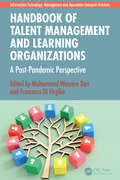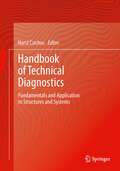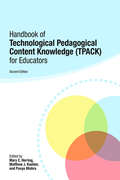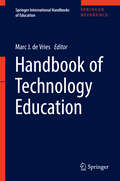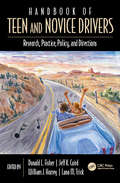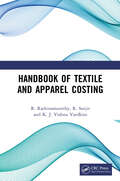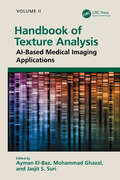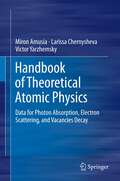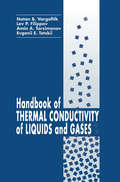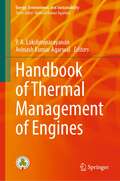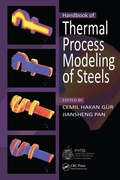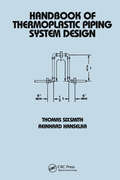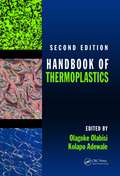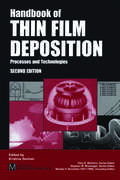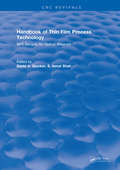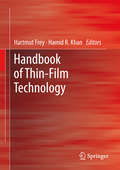- Table View
- List View
Handbook of Systems and Complexity in Health
by Carmel Martin Joachim P SturmbergThis book is an introduction to health care as a complex adaptive system, a system that feeds back on itself. The first section introduces systems and complexity theory from a science, historical, epistemological, and technical perspective, describing the principles and mathematics. Subsequent sections build on the health applications of systems science theory, from human physiology to medical decision making, population health and health services research. The aim of the book is to introduce and expand on important population health issues from a systems and complexity perspective, highlight current research developments and their implications for health care delivery, consider their ethical implications, and to suggest directions for and potential pitfalls in the future.
Handbook of Talent Management and Learning Organizations: A Post-Pandemic Perspective (Information Technology, Management and Operations Research Practices)
by Francesca Di Virgilio Muhammad Waseem BariThis handbook contributes to the advanced knowledge of talent management and learning organizations in the post-pandemic era. It provides new insights and contributions to the existing literature on business organizations through the dissemination of information as well as empirical pieces of evidence from various parts of the world. The focus of this handbook is on advancing talent management strategies and learning organizations through knowledge sharing on various platforms, geographical locations, and diverse groups of intellectuals having diversified experience, knowledge, and expertise. It also focuses on innovation and creativity based on global competition, advanced communication, and management technologies and on changing customers’ behaviors and needs in the post-pandemic era.The Handbook of Talent Management and Learning Organizations: A Post-Pandemic Perspective explores theoretical and empirical artifacts and different approaches to enhance the understanding of the relationship between talent management and learning organization. It provides solutions to managers and consultants who are facing problems while managing talent due to workplace changes post-pandemic and shows the connection between innovation and creativity as talent management enhances organizational learning, knowledge-sharing culture, innovation capabilities, and creativity. The handbook also offers strategies and solutions to manage talent virtually and presents future research directions and solutions to contemporary issues related to talent management and learning organizations moving forward.This handbook targets graduate students, research scholars, practitioners, employees, consultants, corporate bodies, and technocrats. It will be very helpful to managers and consultants who are facing problems with managing talent due to workplace changes after the pandemic.
Handbook of Technical Diagnostics: Fundamentals and Application to Structures and Systems
by Horst CzichosThis book presents concepts, methods and techniques to examine symptoms of faults and failures of structures, systems and components and to monitor functional performance and structural integrity. The book is organized in five parts. Part A introduces the scope and application of technical diagnostics and gives a comprehensive overview of the physics of failure. Part B presents all relevant methods and techniques for diagnostics and monitoring: from stress, strain, vibration analysis, nondestructive evaluation, thermography and industrial radiology to computed tomography and subsurface microstructural analysis. Part C cores the principles and concepts of technical failure analysis, illustrates case studies, and outlines machinery diagnostics with an emphasis on tribological systems. Part D describes the application of structural health monitoring and performance control to plants and the technical infrastructure, including buildings, bridges, pipelines, electric power stations, offshore wind structures, and railway systems. And finally, Part E is an excursion on diagnostics in arts and culture. The book integrates knowledge of basic sciences and engineering disciplines with contributions from research institutions, academe, and industry, written by internationally known experts from various parts of the world, including Europe, Canada, India, Japan, and USA.
Handbook of Technological Pedagogical Content Knowledge (TPACK) for Educators
by Mary C. Herring, Matthew J. Koehler and Punya MishraThe 2nd edition of the Handbook of Technological Pedagogical Content Knowledge (TPACK) for Educators addresses the concept and implementation of technological pedagogical content knowledge—the knowledge and skills that teachers need in order to integrate technology meaningfully into instruction in specific content areas. Driven by the growing influence of TPACK on research and practice in both K-12 and higher education, the 2nd edition updates current thinking about theory, research, and practice. Offering a series of chapters by scholars in different content areas who apply the technological pedagogical content knowledge framework to their individual content areas, the volume is structured around three themes: Current thoughts on TPACK Theory Research on Technological Pedagogical Content Knowledge in Specific Subject Areas Integrating Technological Pedagogical Content Knowledge into Teacher Education and Professional Development The Handbook of Technological Pedagogical Content Knowledge (TPACK) for Educators is simultaneously a mandate and a manifesto on the engagement of technology in classrooms.
Handbook of Technological Sustainability: Innovation and Environmental Awareness
by Pankaj Bhambri and Paula BajdorIn the context of an ever-changing technological world, it is crucial to prioritize the cultivation of sustainability and environmental consciousness. Adopting an interdisciplinary perspective, this handbook facilitates the integration of technology and sustainability by leveraging insights from many fields such as engineering, environmental science, economics, and sociology. The primary objective of this handbook is to provide a comprehensive analysis of the complex relationship between technology and the environment.Handbook of Technological Sustainability: Innovation and Environmental Awareness includes recent and diverse case studies from a global perspective and demonstrates the utilization of technology to achieve sustainable development across several sectors, such as energy, agriculture, transportation, and urban planning. It explores innovative technologies emphasizing state-of-the-art and developing technologies, including renewable energy, circular economy practices, smart cities, and artificial intelligence-driven sustainability solutions. The handbook also examines the impact of laws, regulations, and international agreements on the advancement or impediment of technological sustainability. Written to be used as a reference, this handbook highlights the ethical and moral quandaries linked to technological sustainability analyzing various topics of significance, including environmental justice, privacy implications in smart technology, and the ramifications of artificial intelligence on employment and society. It provides practical methodologies and recommendations for individuals, enterprises, and governmental entities to adopt and integrate sustainable technologies effectively and furnish readers with a comprehensive guide for transitioning towards a more sustainable future.As it showcases perspectives from technologists, sustainability professionals, and policymakers that have the potential to provide a range of opinions and practical insights derived from real-world experiences, this handbook is a book for all individuals, corporations, governments, researchers, and anyone seeking to harness technology to advance sustainability and effectively tackle the multifaceted issues posed by our dynamic global landscape.
Handbook of Technology Education
by Marc J. de VriesThis handbook of technology education offers a state-of-the-art survey of developments in technology education worldwide. It deals with general themes like philosophical foundations, curriculum, teaching and learning, teacher education, and educational technology. It also has some technology-specific topics, such as designing, making, and assessment (portfolios). To focus on the specific learning challenges a separate section of the book is dedicated to sub-domains of technology and engineering, like food, textiles, materials and robotics. Explicit attention is given to the possible role of technology (and engineering) education in Science, Technology, Engineering and Mathematics (STEM) education. Recent developments such as technology concept learning, authentic learning, pre-university engineering education, design-based learning and design-based research for technology education, pedagogical content knowledge for technology educators, and the use of e-portfoli os are included. One section deals with social and cultural issues, such as education for sustainability, gender issues in technology education, indigenous technologies, industry involvement and the relation between technology education and communication. As could be expected in a handbook on technology education, there is also a section on the use of technology for teaching about technology: the use of CAD, science fiction movies, animations, internet and social media. All chapters are written especially for this handbook by a selection of authors, some of whom have been part of the history of technology education for many years, some of whom are promising young researchers. The book can be used as a reference by technology education researchers to get a concise introduction into the field. It can also be used as a resource in technology teacher education programs. Technology teachers can use it as literature for deepening their understanding of the field and thus working on their continuous professionalization. Curriculum developers and policy makers will find it of interest to get an understanding for the need to have technology education in the curriculum and the way it can be realized in practice.
Handbook of Teen and Novice Drivers: Research, Practice, Policy, and Directions
by Donald L. Fisher, Jeff K. Caird, William J. Horrey and Lana M. TrickDespite a growing body of research and targeted remediation, teenage and novice drivers continue to be six to nine times more likely to die in a crash than they are when they are just a few years older. The World Health Organization reports that road traffic injuries are the leading cause of death globally among 15 to 19 year olds. In light of these crash statistics, understanding the teen driver problem remains of paramount public health importance around the world. The Handbook of Teen and Novice Drivers: Research, Practice, Policy, and Directions provides critical knowledge for a broad range of potential readers, including students, teachers, researchers in academics, industry and the federal government, public policy makers at all levels, insurance companies and automobile manufacturers, driving instructors, and parents and their teens.
Handbook of Textile and Apparel Costing
by R. Rathinamoorthy R. Surjit K. J. VardhiniHandbook of Textile and Apparel Costing covers a wider area of the costing aspects of industrial and academic requirements from spinning to the apparel sector.It is a one of its kind in the textile and fashion discipline that covers the cost calculation methods of every manufacturing step in entirety: spinning, weaving, processing, and apparel manufacturing.Print edition not for sale in South Asia (Bangladesh, Bhutan, India, Nepal, Pakistan and Sri Lanka)
Handbook of Texture Analysis: AI-Based Medical Imaging Applications
by Jasjit S. Suri Ayman El-Baz Mohammed GhazalThe major goals of texture research in computer vision are to understand, model, and process texture and, ultimately, to simulate the human visual learning process using computer technologies. In the last decade, artificial intelligence has been revolutionized by machine learning and big data approaches, outperforming human prediction on a wide range of problems. In particular, deep learning convolutional neural networks (CNNs) are particularly well suited to texture analysis. This volume presents important branches of texture analysis methods which find a proper application in AI-based medical image analysis. This book: Discusses first-order, second-order statistical methods, local binary pattern (LBP) methods, and filter bank-based methods Covers spatial frequency-based methods, Fourier analysis, Markov random fields, Gabor filters, and Hough transformation Describes advanced textural methods based on DL as well as BD and advanced applications of texture to medial image segmentation Is aimed at researchers, academics, and advanced students in biomedical engineering, image analysis, cognitive science, and computer science and engineering This is an essential reference for those looking to advance their understanding in this applied and emergent field.
Handbook of Texture Analysis: Generalized Texture for AI-Based Industrial Applications
by Jasjit S. Suri Ayman El-Baz Mohammed GhazalThe major goals of texture research in computer vision are to understand, model, and process texture, and ultimately, to simulate the human visual learning process using computer technologies. In the last decade, artificial intelligence has been revolutionized by machine learning and big data approaches, outperforming human prediction on a wide range of problems. In particular, deep learning convolutional neural networks (CNNs) are particularly well suited to texture analysis. This book examines four major application domains related to texture analysis and their relationship to AI-based industrial applications: texture classification, texture segmentation, shape from texture, and texture synthesis. This volume: Discusses texture-based segmentation for extracting image shape features, modeling and segmentation of noisy and textured images, spatially constrained color-texture model for image segmentation, and texture segmentation using Gabor filters Examines textural features for image classification, a statistical approach for classification, texture classification from random features, and applications of texture classifications Describes shape from texture, including general principles, 3D shapes, and equations for recovering shape from texture Surveys texture modeling, including extraction based on Hough transformation and cycle detection, image quilting, gray level run lengths, and use of Markov random fields Aimed at researchers, academics, and advanced students in biomedical engineering, image analysis, cognitive science, and computer science and engineering, this is an essential reference for those looking to advance their understanding in this applied and emergent field.
Handbook of Theoretical Atomic Physics
by Larissa Chernysheva Miron Amusia Victor YarzhemskyThe aim of this book is to present highly accurate and extensive theoretical Atomic data and to give a survey of selected calculational methods for atomic physics, used to obtain these data. The book presents the results of calculations of cross sections and probabilities of a broad variety of atomic processes with participation of photons and electrons, namely on photoabsorption, electron scattering and accompanying effects. Included are data for photoabsorption and electron scattering cross-sections and probabilities of vacancy decay formed for a large number of atoms and ions. Attention is also given to photoionization and vacancy decay in endohedrals and to positron-atom scattering. The book is richly illustrated. The methods used are one-electron Hartree-Fock and the technique of Feynman diagrams that permits to include many-electron correlations. This is done in the frames of the Random Phase approximation with exchange and the many-body perturbation theory. Newly obtained and previously collected atomic data are presented. The atomic data are useful for investigating the electronic structure and physical processes in solids and liquids, molecules and clusters, astronomical objects, solar and planet atmospheres and atomic nucleus. Deep understanding of chemical reactions and processes is reached by deep and accurate knowledge of atomic structure and processes with participation of atoms. This book is useful for theorists performing research in different domains of contemporary physics, chemistry and biology, technologists working on production of new materials and for experimentalists performing research in the field of photon and electron interaction with atoms, molecules, solid bodies and liquids.
Handbook of Thermal Conductivity of Liquids and Gases
by Natan B. VargaftikHandbook of Thermal Conductivity of Liquids and Gases covers practically all of the data available on the thermalconductivity of pure liquids and gases. Thermal conductivity data included in the book is based on original experimental measurements and correlations recommended or adopted as a standard by the National Standard Reference Data Service of the Russian Federation. New tabulations of thermal conductivity data on high-molecular organic fluids and the alkali metals in both liquid and gaseous states are featured as well. This book will be an important reference for all researchers working in thermodynamics.
Handbook of Thermal Management of Engines (Energy, Environment, and Sustainability)
by P. A. Lakshminarayanan Avinash Kumar AgarwalThis handbook deals with the vast subject of thermal management of engines and vehicles by applying the state of the art research to diesel and natural gas engines. The contributions from global experts focus on management, generation, and retention of heat in after-treatment and exhaust systems for light-off of NOx, PM, and PN catalysts during cold start and city cycles as well as operation at ultralow temperatures. This book will be of great interest to those in academia and industry involved in the design and development of advanced diesel and CNG engines satisfying the current and future emission standards.
Handbook of Thermal Plasmas
by Pierre L. Fauchais Maher I. Boulos Emil PfenderThis authoritative reference presents a comprehensive review of the evolution of plasma science and technology fundamentals over the past five decades. One of this field’s principal challenges has been its multidisciplinary nature requiring coverage of fundamental plasma physics in plasma generation, transport phenomena under high-temperature conditions, involving momentum, heat and mass transfer, and high-temperature reaction kinetics, as well as fundamentals of material science under extreme conditions. The book is structured in five distinct parts, which are presented in a reader-friendly format allowing for detailed coverage of the science base and engineering aspects of the technology including plasma generation, mathematical modeling, diagnostics, and industrial applications of thermal plasma technology. This book is an essential resource for practicing engineers, research scientists, and graduate students working in the field.
Handbook of Thermal Process Modeling Steels
by Cemil Hakan Gür Jiansheng PanAn Emerging Tool for Pioneering Engineers Co-published by the International Federation of Heat Treatment and Surface Engineering.Thermal processing is a highly precise science that does not easily lend itself to improvements through modeling, as the computations required to attain an accurate prediction of the microstructure and properties of work
Handbook of Thermal Science and Engineering
by Francis A. Kulacki Sumanta Acharya Yaroslav Chudnovsky Renato Machado Cotta Ram Devireddy Vijay K. Dhir M. Pinar Mengüç Javad Mostaghimi Kambiz VafaiThis Handbook provides researchers, faculty, design engineers in industrial R&D, and practicing engineers in the field concise treatments of advanced and more-recently established topics in thermal science and engineering, with an important emphasis on micro- and nanosystems, not covered in earlier references on applied thermal science, heat transfer or relevant aspects of mechanical/chemical engineering. Major sections address new developments in heat transfer, transport phenomena, single- and multiphase flows with energy transfer, thermal-bioengineering, thermal radiation, combined mode heat transfer, coupled heat and mass transfer, and energy systems. Energy transport at the macro-scale and micro/nano-scales is also included. The internationally recognized team of authors adopt a consistent and systematic approach and writing style, including ample cross reference among topics, offering readers a user-friendly knowledgebase greater than the sum of its parts, perfect for frequent consultation. The Handbook of Thermal Science and Engineering is ideal for academic and professional readers in the traditional and emerging areas of mechanical engineering, chemical engineering, aerospace engineering, bioengineering, electronics fabrication, energy, and manufacturing concerned with the influence thermal phenomena.
Handbook of Thermoplastic Piping System Design (Mechanical Engineering)
by Thomas Sixsmith Reinhard HanselkaOffers coverage of design, engineering, chemical resistance, costs, standards, codes and specifications. The text provides a resistance guide that lists over 800 chemicals and nearly 400 trade names cross-referenced to formal chemical names, covering all known chemical resistance data for the most popular thermoplastic piping systems. The book cove
Handbook of Thermoplastics (Plastics Engineering)
by Olagoke Olabisi Kolapo AdewaleThis new edition of the bestselling Handbook of Thermoplastics incorporates recent developments and advances in thermoplastics with regard to materials development, processing, properties, and applications. With contributions from 65 internationally recognized authorities in the field, the second edition features new and updated discussions of seve
Handbook of Thin Film Deposition Techniques Principles, Methods, Equipment and Applications, Second Editon
by Krishna SeshanThe Handbook of Thin Film Deposition Techniques: Principles, Methods, Equipment and Applications, Second Edition explores the technology behind the spectacular growth in the silicon semiconductor industry and the continued trend in miniaturization over the last 20 years. This growth has been fueled in large part by improved thin film deposition tec
Handbook of Thin Film Process Technology: 98/1 Reactive Sputtering
by David A GlockerThe Handbook of Thin Film Process Technology is a practical handbook for the thin film scientist, engineer and technician. This handbook is regularly updated with new material, and this volume is a special issue on reactive sputtering which will be of interest to a wide range of industrial and academic researchers in addition to owners of the main Handbook. Some recent developments in the reactive sputtering field are covered, including unbalanced magnetron sputtering and pulsed reactive sputtering. The articles contain a wealth of practical information relating to applications, practice and manufacturing techniques.
Handbook of Thin Film Process Technology: 98/2 Recipes for Optical Materials
by D GlockerThe Handbook of Thin Film Process Technology is a practical handbook for the thin film scientist, engineer and technician. This handbook is regularly updated with new material, and this volume presents additional recipe-type information (i.e. important deposition system details and process parameters) for optical materials.
Handbook of Thin-Film Technology
by Hartmut Frey Hamid R. Khan"Handbook of Thin Film Technology" covers all aspects of coatings preparation, characterization and applications. Different deposition techniques based on vacuum and plasma processes are presented. Methods of surface and thin film analysis including coating thickness, structural, optical, electrical, mechanical and magnetic properties of films are detailed described. The several applications of thin coatings and a special chapter focusing on nanoparticle-based films can be found in this handbook. A complete reference for students and professionals interested in the science and technology of thin films.
Handbook of Tissue Optical Clearing: New Prospects in Optical Imaging
by Valery V. Tuchin, Dan Zhu, and Elina A. GeninaBiomedical photonics is currently one of the fastest growing fields, connecting research in physics, optics, and electrical engineering coupled with medical and biological applications. It allows for the structural and functional analysis of tissues and cells with resolution and contrast unattainable by any other methods. However, the major challenges of many biophotonics techniques are associated with the need to enhance imaging resolution even further to the sub-cellular level as well as translate them for in vivo studies. The tissue optical clearing method uses immersion of tissues into optical clearing agents (OCAs) that reduces the scattering of tissue and makes tissue more transparent and this method has been successfully used ever since. This book is a self-contained introduction to tissue optical clearing, including the basic principles and in vitro biological applications, from in vitro to in vivo tissue optical clearing methods, and combination of tissue optical clearing and various optical imaging for diagnosis. The chapters cover a wide range of issues related to the field of tissue optical clearing: mechanisms of tissue optical clearing in vitro and in vivo; traditional and innovative optical clearing agents; recent achievements in optical clearing of different tissues (including pathological tissues) and blood for optical imaging diagnosis and therapy. This book provides a comprehensive account of the latest research and possibilities of utilising optical clearing as an instrument for improving the diagnostic effectiveness of modern optical diagnostic methods. The book is addressed to biophysicist researchers, graduate students and postdocs of biomedical specialties, as well as biomedical engineers and physicians interested in the development and application of optical methods in medicine. Key features: The first collective reference to collate all known knowledge on this topic Edited by experts in the field with chapter contributions from subject area specialists Brings together the two main approaches in immersion optical clearing into one cohesive book
Handbook of Transition Metal Polymerization Catalysts
by Ray HoffIncluding recent advances and historically important catalysts, this book overviews methods for developing and applying polymerization catalysts – dealing with polymerization catalysts that afford commercially acceptable high yields of polymer with respect to catalyst mass or productivity.• Contains the valuable data needed to reproduce syntheses or use the catalyst for new applications• Offers a guide to the design and synthesis of catalysts, and their applications in synthesis of polymers • Includes the information essential for choosing the appropriate reactions to maximize yield of polymer synthesized• Presents new chapters on vanadium catalysts, Ziegler catalysts, laboratory homopolymerization, and copolymerization
Handbook of Transparent Conductors
by David S. Ginley Hideo Hosono David C. PaineTransparent conducting materials are key elements in a wide variety of current technologies including flat panel displays, photovoltaics, organic, low-e windows and electrochromics. The needs for new and improved materials is pressing, because the existing materials do not have the performance levels to meet the ever- increasing demand, and because some of the current materials used may not be viable in the future. In addition, the field of transparent conductors has gone through dramatic changes in the last 5-7 years with new materials being identified, new applications and new people in the field. "Handbook of Transparent Conductors" presents transparent conductors in a historical perspective, provides current applications as well as insights into the future of the devices. It is a comprehensive reference, and represents the most current resource on the subject.

